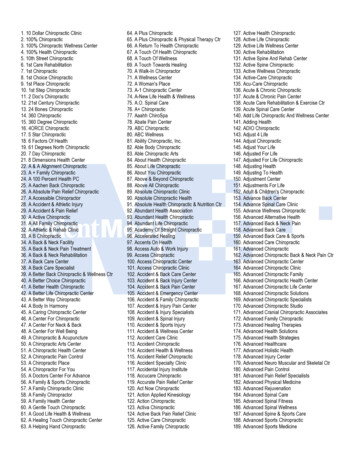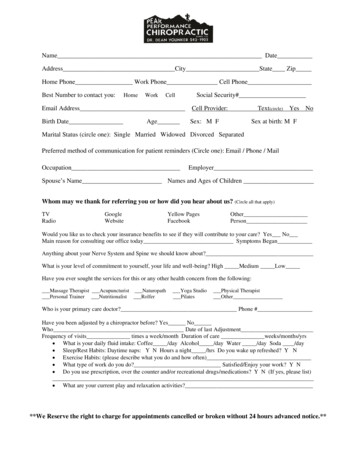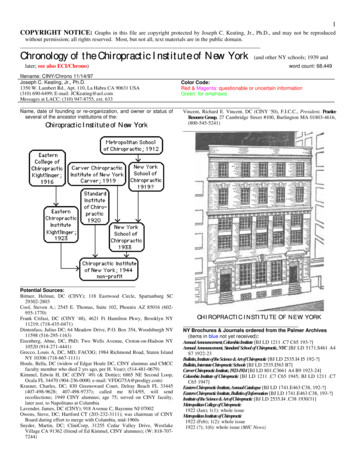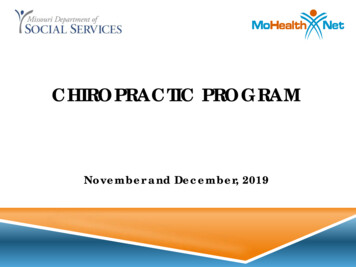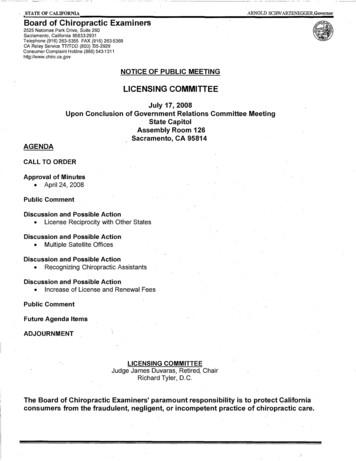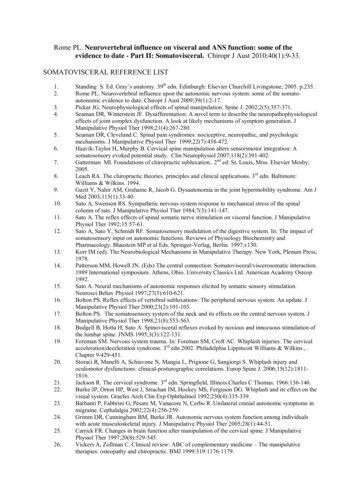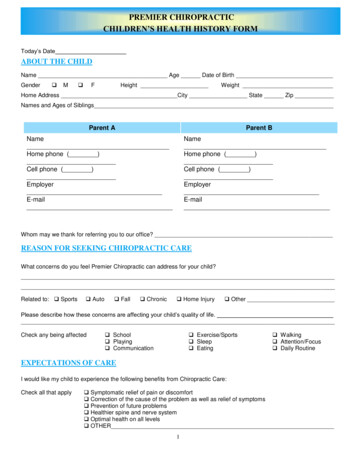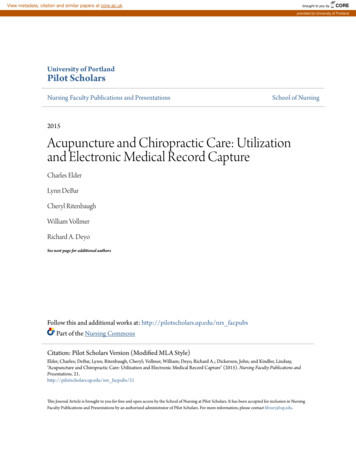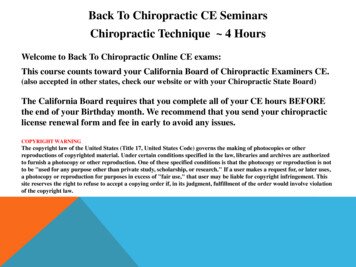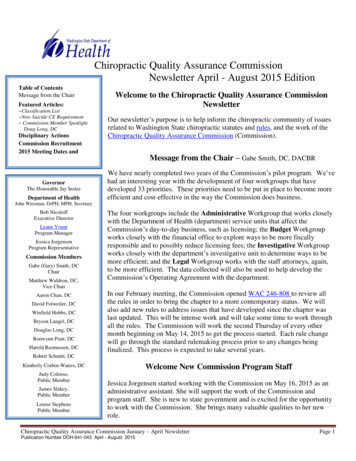
Transcription
MN E-HEALTH REPORT:Chiropractic Offices’ Adoptionand Use of EHRs and Exchangeof Health Information (2011)April 2012
MN E‐Health Report:Chiropractic OfficeIntroductionCONTENTSE‐health is the adoption and effective use of electronic healthrecords (EHRs) and other health information technology (HIT) toimprove health care quality and accessibility, increase patientsafety, reduce health care costs and improve public health. TheMinnesota Department of Health, in partnership with theMinnesota e‐health Initiative, is responsible for assessing e‐healthin a variety of settings. The assessment information is used to:Highlights .3Demographics .4Adoption . .7Use 17Exchange . 38Conclusion . 42Appendix .43 MEASURE Minnesota’s status on achieving state and nationalgoals to accelerate adoption and use of electronic healthrecords and other HIT and to achieve interoperability of healthinformationIDENTIFY gaps and barriers to enable effective strategies andefficient use of resourcesHelp DEVELOP programs and INFORM decisions at the local,state and federal levels of government ; andSUPPORT community collaborative effortsMethods, Acknowledgements,Definitions, & ResourcesCONTACTKari Guida, MPHHIT Assessment CoordinatorOffice of HITMinnesota Department of Healthkari.guida@state.mn.us2
HighlightsThis report is the result of collaborative effort by numerous communitypartners to develop the first known report on chiropractic offices’adoption and use and exchange of health information. The followinganalysis are based on the response of 277 Minnesota chiropracticoffices, a response rate of 34% (277/803), which describe the status ofchiropractic offices in late 2011 and early 2012. Please note thatbecause of the low response rate the survey may not be representativeof all Minnesota chiropractic offices and the low response rate will limitthe ability to draw inferences from the data.MN E‐Health Report:Chiropractic OfficesAlthough the responserate was low, findingssuggest that about 25%of chiropractic officesadopt and use EHRs,with limited electronicexchange of healthinformation occurring.HIGHLIGHTS OF THE FINDINGS INCLUDE: 25% of chiropractic offices had an EHR (pg. 7) with size (pg. 9) andaffiliation with a health system (pg. 10) factors in EHR adoption55% of chiropractic offices without an EHR plan to implement anEHR in the next 1 to 3 years (pg. 14)Common barriers to EHR implementation were cost to acquire(77%) and return on investment concerns (53%) (pg. 15)Documentation was the most common use of the EHR (pgs. 23‐25)23% indicated achieving electronic exchange of health informationwith 65% indicating a need to exchange with radiology providersand offices (pgs. 39‐41)Barriers identified aspreventing adoption,use, and electronicexchange included cost,training, andknowledge.3
Chiropractic Offices by Number ofChiropractic Practitioners (N 277)Number ofChiropracticPractitionersPercent &Number171% (196)220% (56)35% (13)43% (8)No Response1% (4)Total277MN E‐Health Report:Chiropractic OfficesDemographicsNinety‐one percent ofchiropractic offices hadtwo or fewerchiropracticpractitioners.No chiropractic officesreported more than fourchiropracticpractitioners.Source: Minnesota Department of Health, Office of Health InformationTechnology, MN HIT Chiropractic Office Survey (2011)Response Rate: 34% (277/803)4
Chiropractic Offices by Rural‐UrbanCommuting Areas (N 277)Number ofChiropracticPractitionersPercent &NumberUrban56% (154)Large Rural17% (46)Small Rural15% (42)Isolated13% (35)Total277MN E‐Health Report:Chiropractic OfficesDemographicsFifty‐six percent ofchiropractic offices werein urban areas.The remaining 44%were in rural areas.Source: Minnesota Department of Health, Office of Health InformationTechnology, MN HIT Chiropractic Office Survey (2011)Response Rate: 34% (277/803)5
Chiropractic Offices by Affiliationwith Health System or Hospitals(N 277)Percent & NumberIndependent chiropractic officeMost (92%) ofchiropractic offices wereindependent.92% (256)Chiropractic office practicing inor part of a health system orhospital5% (14)Did not respond3% (7)TotalMN E‐Health Report:Chiropractic OfficesDemographicsFive percent ofchiropractic offices werepracticing in or part of ahealth system orhospital.277Source: Minnesota Department of Health, Office of Health InformationTechnology, MN HIT Chiropractic Office Survey (2011)Response Rate: 34% (277/803)6
EHR Status of MN Chiropractic Offices(N 277)Percent & NumberNo EHR*Two‐thirds ofchiropractic offices hadno EHR (185).67% (185)In process8% (23)EHR installed and in use*25% (69)TotalMN E‐Health Report:Chiropractic OfficesAdoptionEight percent were inprocess, havingpurchased or startedimplementation, butwere not using the EHR.277*11 chiropractic offices misidentified as having an “EHR installed and use” andwere reclassified as “No EHR”, see methodology for more detailSource: Minnesota Department of Health, Office of Health InformationTechnology, MN HIT Chiropractic Office Survey (2011)Response Rate: 34% (277/803)The remaining 25% hadan EHR and were usingit.7
EHR Status of MN ChiropracticOffices by Rural‐Urban CommutingAreas (N 277)UrbanLargeRuralSmallRuralIsolatedNo EHR*(N 185)67% (103)52% (24)67% (28)86% (30)In process(N 23)8% (13)13% (6)5% (2)6% (2)EHR installedand in use*(N 185)25% (38)35% (16)29% (12)9% (3)154464235Total(N 277)MN E‐Health Report:Chiropractic OfficesAdoptionChiropractic offices inlarge rural and smallrural areas had higherEHR adoption rates thanthose in urban andisolated areas.A high percent, 86%, ofchiropractic offices inisolated areas had noEHR.*11 chiropractic offices misidentified as having an “EHR installed and use” andwere reclassified as “No EHR”, see methodology for more detailSource: Minnesota Department of Health, Office of Health InformationTechnology, MN HIT Chiropractic Office Survey (2011)Response Rate: 34% (277/803)8
EHR Status of MN ChiropracticOffices by Number of ChiropracticPractitioners (N 277)Number of Chiropractic Practitioners1234No EHR*(N 185)74% (145)48% (27)31% (4)63% (5)In process(N 23)6% (11)16% (9)15% (2)13% (1)EHR installedand in use*(N 185)Total(N 277)20% (40)36% (20)54% (7)25% (2)19656138MN E‐Health Report:Chiropractic OfficesAdoptionChiropractic offices withone chiropracticpractitioner had lowerEHR adoption rates (EHRinstalled and use) thanoffices with more thanone practitioner.Almost three‐fourths ofchiropractic offices withone provider had noEHR.*11 chiropractic offices misidentified as having an “EHR installed and use” andwere reclassified as “No EHR”, see methodology for more detailSource: Minnesota Department of Health, Office of Health InformationTechnology, MN HIT Chiropractic Office Survey (2011)Response Rate: 34% (277/803)9
EHR Status of MN Chiropractic Officesby Affiliation Status (N 277)Non-Affiliated(Independent)Affiliated(Part of HealthSystem orHospital)No EHR*(N 185)68% (174)36% (5)In process(N 23)9% (22)0% (0)EHR installed and inuse* (N 185)23% (60)64% (9)25614Total(N 277)***11 chiropractic offices misidentified as having an “EHR installed and use” andwere reclassified as “No EHR”, see methodology for more detail**7 chiropractic offices did not indicate affiliation.Source: Minnesota Department of Health, Office of Health InformationTechnology, MN HIT Chiropractic Office Survey (2011)Response Rate: 34% (277/803)MN E‐Health Report:Chiropractic OfficesAdoptionOf the 14 chiropracticoffices indicatingaffiliation with a healthsystem or hospital, 64%had an EHR installedand in use compared to23% of non‐affiliatedchiropractic offices.10
Common EHR Vendors Used by MNChiropractic Offices (N 69)EHR Vendore-Connect Future HealthPercent & Number20% (14)Epic9% (6)Chart Talk7% (5)Write Pad7% (5)Chiro Quick Charts6% (4)Eclipse6% (4)RAPID/ACOM6% (4)MN E‐Health Report:Chiropractic OfficesAdoptionThe seven mostcommon EHR systemsaccounted for 61% of allchiropractic offices withan EHR.E‐Connect Future Healthwas the most commonEHR system (20%).All six of the offices withEPIC were part of ahealth system orhospital.Source: Minnesota Department of Health, Office of Health InformationTechnology, MN HIT Chiropractic Office Survey (2011)Response Rate: 34% (277/803)11
MN Chiropractic Offices Use ofPaper Charts (N 69)MN E‐Health Report:Chiropractic OfficesAdoptionOver half of chiropracticoffices with EHRs (55%)used a combination ofpaper charts and EHRsystems.Twenty‐eight percentreported being entirelypaperless, notmaintaining a paperchart.12
The Year EHR Systems wereInstalled in MN ChiropracticOffices (N 69)MN E‐Health Report:Chiropractic OfficesAdoptionMost chiropractic officeswith EHRs completed orwere completinginstallation in 2011.Twenty‐six percentreported installationcomplete between 2008‐2010.13
Plans to Acquire and Implement an EHRin MN Chiropractic Offices without anEHR (N 208)Plans to Acquire and ImplementPercent & NumberAre going to purchase and implementwithin the year15% (32)Planning/exploring with implementationwithin 1-3 years23% (48)Not planning/exploring but want toimplement within 1-3 years17% (35)Planning/exploring with implementationwithin 4-5 years3% (6)Not planning/exploring but want toimplement within 4-5 years12% (25)No plans to implement within next 1-5 years23% (48)Source: Minnesota Department of Health, Office of Health InformationTechnology, MN HIT Chiropractic Office Survey (2011)Response Rate: 34% (277/803)MN E‐Health Report:Chiropractic OfficesAdoptionFifty‐five percent ofchiropractic offices(115) without an EHRplan to implement anEHR in the next 1 to 3years.Almost a quarter ofoffices without an EHRreported no plans toimplement an EHR inthe next 1‐5 years.14
Challenges to EHR Implementation byMN Chiropractic Offices Not Using anEHR (N 208)Challenges to EHRImplementationAll(N 208)In Process(N 23)No EHR(N 185)Cost to acquire77% (161)52% (12)81% (149)Return-on-investment concerns53% (110)30% (7)56% (103)Staff education and training49% (102)74% (17)46% (85)Internal knowledge/technicalresources47% (98)61% (14)45% (84)Chiropractic practitionersupport31% (65)43% (10)30% (55)Security/privacy concerns26% (54)22% (5)26% (49)Staff support25% (51)26% (6)24% (45)Administration support17% (36)13% (3)18% (33)Vendor availability17% (29)0% (0)16% (29)Non-physician provider support7% (14)4% (1)7% (13)Source: Minnesota Department of Health, Office of Health InformationTechnology, MN HIT Chiropractic Office Survey (2011)Response Rate: 34% (277/803)MN E‐Health Report:Chiropractic OfficesAdoptionThe cost to acquire wasthe most commonchallenge to EHRimplementation bychiropractic offices withno EHR (81%).For chiropractic officesin process ofimplementing an EHRthe most commonchallenge was staffeducation and training(74%).15
EHR‐Related Workforce Needs of MNChiropractic Offices (N 277)Workforce NeedsAll(N 277)EHR(N 69)InProcess(N 23)NoEHR(N 185)People to help design,customize, and/or maintain EHR45%(126)19%(13)43%(10)56%(103)A person to lead theimplementation of the EHR40%(112)12%(8)43%(10)51%(94)People to get the EHR ready foruse (enter orders, mputer/IT personnel32%(90)25%(17)22%(5)37%(68)Chiropractic practitioners, office,or other 7)43%(10)9%(16)Source: Minnesota Department of Health, Office of Health InformationTechnology, MN HIT Chiropractic Office Survey (2011)Response Rate: 34% (277/803)MN E‐Health Report:Chiropractic OfficesAdoptionThe EHR‐related workforceneeds varied across EHRadoption status.Chiropractic offices with noEHR needed people to helpdesign, customize, ormaintain the EHR (56%).Chiropractic offices inprocess of getting an EHRneeded people to get theEHR ready for use (61%).Computer or IT personnelare needed in chiropracticoffices currently using theEHR (25%).16
Use of Computerized ProviderOrder Entry (CPOE) in MNChiropractic Offices (N 69)MN E‐Health Report:Chiropractic OfficesUseTwenty‐seven percentof chiropractic officeswith an EHR used CPOEfor some or all providerorders.Another 35% had theCPOE function but itwas not in use or wasturned off.CPOE was not part ofthe EHR for 38% ofchiropractic offices.17
Challenges to Using CPOE by MNChiropractic Offices (N 69)ChallengesPercent &NumberRequires staff training29% (20)Time too limited during patient encounter touse23% (16)Building orders into system takes time19% (13)Requires maintenance16% (11)Some chiropractic practitioners usehandwritten or paper orders14% (10)Hardware issues (computers not available inall exam rooms, etc.)14% (10)Requires a system upgrade12% (8)Source: Minnesota Department of Health, Office of Health InformationTechnology, MN HIT Chiropractic Office Survey (2011)Response Rate: 34% (277/803)MN E‐Health Report:Chiropractic OfficesUseThe most commonbarriers to using CPOEwere staff training (29%)and limited time duringthe patient encounter(23%).18
Use of Clinical Decision Support Toolsin MN Chiropractic Offices (N 69*)RoutinelyUsedOccasionallyUsedNot UsedPatient specific or condition specificreminders33% (23)22% (15)36% (25)Clinical guidelines based on patientproblem list, gender, and age30% (21)22% (15)41% (28)Allergy/dietary interaction alerts25% (17)29% (20)36% (25)Preventive care services due (e.g. ageappropriate screenings)17% (12)29% (20)45% (31)Automated reminders for missing labsand tests (e.g. diagnostic tests)14% (10)14% (10)61% (42)Chronic care plans and flow sheets13% (9)33% (23)43% (30)High tech diagnostic imaging decisionsupport tools10% (7)23% (16)58% (40)Clinical Decision Support Tools*Between 5 to 7 chiropractic offices did not respondSource: Minnesota Department of Health, Office of Health InformationTechnology, MN HIT Chiropractic Office Survey (2011)Response Rate: 34% (277/803)MN E‐Health Report:Chiropractic OfficesUseSeventy‐four percent ofchiropractic offices withEHRs used decisionsupport tools includingroutine use of: Patient specific orcondition specificreminders (33%) Clinical guidelines(30%) Allergy/dietaryinteraction alerts(25%)19
Barriers to Using Clinical DecisionSupport Tools by MN ChiropracticOffices (N 69)BarriersPercent &NumberRequires staff and/or chiropractic practitioner training39% (27)Requires resources to build/implement26% (18)Too many false alarms/too disruptive19% (13)Requires a system upgrade14% (10)Hardware issues (computers not available in allexam rooms, etc.)13% (9)Software not available12% (8)Source: Minnesota Department of Health, Office of Health InformationTechnology, MN HIT Chiropractic Office Survey (2011)Response Rate: 34% (277/803)MN E‐Health Report:Chiropractic OfficesUseThe most commonbarriers to using clinicaldecision support toolswere requires stafftraining (39%) andrequires resources tobuild/implement (26%).20
Retrieval of Lab and DiagnosticTest Results by MN ChiropracticOffices (N 69)MN E‐Health Report:Chiropractic OfficesUseForty‐one percent ofchiropractic offices withEHRs used paper, faxes,or phone calls as theprimary method toretrieve lab anddiagnostic test results.The remaining officesregularly (17%) oroccasionally (28%) usedthe computer toretrieve the test results.21
MN Chiropractic OfficesIncorporating Lab Test Results inEHR (N 69)MN E‐Health Report:Chiropractic OfficesAdoptionForty‐two percent ofchiropractic offices withan EHR were notrecording lab results asstructured data in theEHR.Another 32% wererecording lab results asstructured data in theEHR.22
MN Chiropractic Offices that Maintainan Up‐To Date Problem List for EachPatient within the EHR (N 69)Percent and NumberMore than 80% of patients68% (47)Less than 80% of patients10% (7)Do not maintain problem lists6% (4)Not Sure3% (2)Did not respond13% (9)MN E‐Health Report:Chiropractic OfficesUseSixty‐eight percent ofchiropractic offices withEHR systems maintainedup‐to‐date problem listsfor more than 80% ofpatients.A problem list is a list ofthe patient’s diagnosesand conditions‐including pastconditions that mayimpact current healthstatus.Source: Minnesota Department of Health, Office of Health InformationTechnology, MN HIT Chiropractic Office Survey (2011)Response Rate: 34% (277/803)23
MN Chiropractic Offices that Trackand Record Vital Signs in the EHR forPatient Encounters (N 69)Not 80% of 80% of collected or Did NotVital SignsEncounters Encounters turned on/ RespondNot SureHeight51% (35)26% (18)10% (7)13% (9)Weight52% (36)25% (17)9% (7)13% (9)49% (34)29% (20)9% (6)13% (9)43% (30)26% (18)16% (11)14% (10)BloodPressureBody MassIndex (BMI)MN E‐Health Report:Chiropractic OfficesUseAbout half ofchiropractic offices withEHRs were able to trackand record vital signs inthe EHR for more than80% of the patientencounters for weight,blood pressure, andheight.Slightly fewer officeswere able to track andrecord body mass index.Source: Minnesota Department of Health, Office of Health InformationTechnology, MN HIT Chiropractic Office Survey (2011)Response Rate: 34% (277/803)24
MN Chiropractic Offices that Track TobaccoSmoking Status in the EHR (N 69)StatusMore than 80% of patients aged13 Less than 80% of patients aged13 Do not record in EHRPercent and Number59% (41)9% (6)MN E‐Health Report:Chiropractic OfficesUseFifty‐nine percent ofchiropractic offices withEHR systems were ableto track tobaccosmoking in the EHR for80% or more ofpatients.14% (10)Not Sure4% (3)Did not respond13% (9)Source: Minnesota Department of Health, Office of Health InformationTechnology, MN HIT Chiropractic Office Survey (2011)Response Rate: 34% (277/803)25
Ability to Provide Patients with ClinicalSummaries within Three Business Days byMN Chiropractic Offices (N 69)Percent and NumberMore than 80% of allencounters39% (27)Less than 80% of all encounters14% (10)Do not provide clinicalsummariesDo not have function/functionturned off23% (16)4% (3)Not Sure6% (4)Did not respond13% (9)MN E‐Health Report:Chiropractic OfficesUseThirty‐nine percent ofchiropractic office withEHR systems had theability to providepatients with clinicalsummaries within threebusiness days for morethan 80% of patientencounters.Almost a quarter ofoffices did not provideclinical summaries.Source: Minnesota Department of Health, Office of Health InformationTechnology, MN HIT Chiropractic Office Survey (2011)Response Rate: 34% (277/803)26
MN Chiropractic Offices’ Ability to ProvidePatients with Electronic Access to HealthInformation within Four Business Days (N 69)Percent and NumberMore than 80% of patients30% (21)Less than 80% of patients9% (6)Do not provide electronicaccessDo not have function/functionturned off4% (3)30% (21)Not Sure13% (9)Did not respond13% (9)MN E‐Health Report:Chiropractic OfficesUseSlightly less than a thirdof chiropractic officeswith EHRs were able toprovide patients withelectronic access totheir health informationwithin four businessdays for more than 80%of patients.Another third did nothave the function or itwas turned off.Source: Minnesota Department of Health, Office of Health InformationTechnology, MN HIT Chiropractic Office Survey (2011)Response Rate: 34% (277/803)27
MN Chiropractic Offices’ Ability to ProvidePatients with an Electronic Copy of HealthInformation within Three Business Days (N 69)Percent and NumberMore than 80% of requestsLess than 80% of requestProvide electronic copies butmore than 3 business daysDo not provide electroniccopiesDo not have function/functionturned off43% (30)4% (3)1% (1)26% (18)4% (3)Not Sure7% (5)Did not respond13% (9)Source: Minnesota Department of Health, Office of Health InformationTechnology, MN HIT Chiropractic Office Survey (2011)Response Rate: 34% (277/803)MN E‐Health Report:Chiropractic OfficesUseForty‐three percent ofchiropractic offices withEHRs were able toprovide patients withelectronic copies of theirhealth information withinthree business days formore than 80% ofrequests.Common methodsincluded: Personal health recordor patient portal (20) Secure email (19) Flash or USB drive (16)28
Use of EHR to Identify Patient‐SpecificEducational Resources by MNChiropractic Offices (N 69)MN E‐Health Report:Chiropractic OfficesAdoptionHalf of chiropracticoffices with EHRs wereusing the EHR toidentify patient‐specificeducational resources.29
Status of Care Plan Use by MNChiropractic Offices (N 69)StatusPercent and NumberUse EHR to provide care plans41% (28)Use paper or manual system toprovide care plans17% (12)Do not use care plans13% (9)Not sure14% (10)Did not respond14% (10)Source: Minnesota Department of Health, Office of Health InformationTechnology, MN HIT Chiropractic Office Survey (2011)Response Rate: 34% (277/803)MN E‐Health Report:Chiropractic OfficesUseForty‐one percent ofchiropractic offices withEHRs were able toprovide care plans usingthe EHR.Common methods toshare care plansincluded: Secure email (12) Flash or USB drive(12) Personal healthrecord or patientportal (11)30
MN Chiropractic Offices thatAllow Patients to Set PrivacyStandards (N 69)MN E‐Health Report:Chiropractic OfficesUseThree‐fourths ofchiropractic offices withEHRs allow patients toauthorize the release ofhealth information.More than half allowpatients to definepermission for access bystaff (55%) andpreference for healthinformation sharing(58%).31
Privacy and Security Activities ofMN Chiropractic Offices (N 69)MN E‐Health Report:Chiropractic OfficesUseSixty‐five percent ofchiropractic offices withEHRs used the EHR tolimit users’ access toonly informationneeded.Fifty‐five percent ofoffices conducted orreviewed security riskanalysis information.32
MN Chiropractic Offices’Methods for Tracking PatientConsent (N 69)MN E‐Health Report:Chiropractic OfficesUseChiropractic offices withEHRs identified themost common methodfor tracking patientconsent as paperconsents, filed as paper(45%).33
MN Chiropractic Offices Methods forTracking Advanced Directives/PatientPreferences (N 69)MN E‐Health Report:Chiropractic OfficesUseThirty‐eight percent ofchiropractic offices withEHRs used paperdocuments to trackadvance directives/patient preferenceswhile 36% used theEHR.34
MN Chiropractic Offices’ Use of Datafrom the EHR for Internal QualityImprovement Efforts (N 69)MN E‐Health Report:Chiropractic OfficesUseThe most common useof data from the EHR forquality improvementefforts was to sharedata with providers(55%).35
Routine Use of EHRs for Preventiveand Follow‐up Reminders by MNChiropractic Offices (N 69)MN E‐Health Report:Chiropractic OfficesUseChiropractic offices withan EHR used the EHRroutinely to: Identify and remindpatients ofpreventive services(32%) Send patientreminders for follow‐ups (29%)36
Demographic Information Captured inEHRs by MN Chiropractic Offices (N 69)MN E‐Health Report:Chiropractic OfficesUseGender, age andinsurance type werecaptured in EHRs by atleast 75% of chiropracticoffices.Less than 60% of officescaptured race, ethnicityor country of origin.37
Electronic Exchange of HealthInformation by MN Chiropractic Offices(N 69)MN E‐Health Report:Chiropractic OfficesExchangeTwenty‐three percent ofchiropractic offices withEHRs reportedelectronic exchange ofhealth information.Electronic exchangeexcludes exchange withpatients38
Electronic Exchange of MN ChiropracticOffices by Partner (N 69)Exchange PartnerSendReceiveHospitals3 (4%)8 (12%)Neurology providers/offices2 (3%)3 (4%)Orthopedics providers/offices3 (4%)1 (1%)Other care setting0 (0%)1 (1%)Providers (outside of system)6 (9%)3 (4%)Radiology providers/offices6 (9%)11 (16%)MN E‐Health Report:Chiropractic OfficesExchangeThe most commonexchange partners forchiropractic offices withEHRs were radiologyproviders/offices,hospitals, and providers(outside of system).Source: Minnesota Department of Health, Office of Health InformationTechnology, MN HIT Chiropractic Office Survey (2011)Response Rate: 34% (277/803)39
Needed Exchange Partners Identified byMN Chiropractic Offices with EHRs (N 69)MN E‐Health Report:Chiropractic OfficesExchangeSixty‐five percent ofchiropractic offices withEHRs indicated a needto electronicallyexchange with radiologyproviders/offices.Health plans (57%) andother chiropracticoffices (54%) were alsoidentified as neededexchange partners.40
Challenges to Electronic InformationExchange with Outside OrganizationsIdentified by MN Chiropractic Offices (N 69)ChallengesPercent andNumberUnclear value on return on investment35% (24)HIPAA, privacy or legal concerns28% (19)Lack of or access to technical support or expertise22% (15)Insufficient information on exchange optionsavailable19% (13)Capabilities of others to receive electronic dataunknown or not as proficient as our organization19% (13)Subscription rates for exchange services are too high12% (8)Competing priorities12% (8)Inability of system to generate/receive electronicmessages/transactions in standardized format10% (7)Clinical data is not available to access from partners7% (5)Source: Minnesota Department of Health, Office of Health InformationTechnology, MN HIT Chiropractic Office Survey (2011)Response Rate: 34% (277/803)MN E‐Health Report:Chiropractic OfficesExchangeChiropractic offices withEHRs identified themost common barriersto electronic exchangeof information withoutside organizations asthe unclear value onreturn on investment(35%) and HIPPA,privacy or legal concerns(28%).41
ConclusionA quarter of respondents had an EHR (69/277). Theresults suggest that factors which increase EHRadoption include having more than one chiropracticpractitioner (size of practice) and affiliated with ahealth system.The barriers to adoption, use, and exchangeindicated by chiropractic offices were similar to thoseidentified by ambulatory clinics1. Therefore toolsdeveloped for the ambulatory clinics may beapplicable for chiropractic offices, making addressingthe barriers easier. These tools will be of particularinterest to the 55% of chiropractic offices withoutEHRs that indicated plans to adopt an EHR in thenext three year.The most common use of the EHR occurred arounddocumentation including vital signs, smoking status,and problem lists. For use to increase beyonddocumentation, more chiropractic‐specific functionsneed to be developed by EHR vendors.1. clinics).The exchange of health information was limited to a fewof chiropractic offices with EHRs with exchangehappening most frequently with radiology offices andproviders. These providers were also the mostcommonly identified partner need for electronicexchange. This indicates an area to leverage and showthe benefits of exchange between these twocommunities.The low response rate of 34% (277/803), discussed inthe methods, not only affects the results but mayindicate a lack of understanding or interest by thechiropractic community in EHR adoption and use,electronic health information exchange, and meaningfuluse. This indicates a need to provide education andtraining to chiropractors throughout the state.For future surveys, the age of practitioners and years ofretirement should be included. With so many officeshaving only 1 or 2 practitioners, this characteristic couldgreatly affect plans and barriers to EHR adoption anduse and health information exchange.Minnesota chiropractic offices are joining themovement to adopt and use EHRs and achieve healthinformation exchange. to help chiropractic officesaddress the barriers and gaps from the survey, it isnecessary to identify and implement strategies,resources, and collaboration.42
Appendix MethodsThe data in this summary contains the most up‐to‐date information on the adoption and use of EHRsand other HIT and exchange of health information inMinnesota chiropractic offices. The primary source ofthe data is the MN Health Information Technology(HIT) Chiropractic Offices Survey (Chiropractic OfficesSurvey).The Chiropractic Office Survey was adapted from the2011 MN Health Information Technology (HIT)Ambulatory Clinic Survey with approval from theMinnesota Department of Health and MinnesotaCommunity Measurement.The Chiropractic Office Survey was sent out inNovember 2011 to January 2012, to identifiedchiropractic offices through email with a link to boththe paper and online survey. Multiple contacts, bothemail and telephone, were made to the chiropracticoffices to increase the number of respondents. Thesurvey was voluntary with a response rate of 34%,with 277 of 803 Minnesota chiropractic officesresponding.To validate the EHR adoption rate, those with an EHRinstalled and in use, the list of software vendorsselected by respondents was reviewed and thoseindicating a practice management system werereclassified as having no EHR. This occurred with 11chiropractic offices.Analysis on the EHR use and health informationexchange included only the 69 chiropractic offices withEHRs installed and in use.Please note that because of the low response rate thesurvey may not be representative of all Minnesotachiropractic offices and the low response rate will limitthe ability to draw inferences from the data.43
Appendix Acknowledgements, Definitions, ResourcesThe authors wishes to acknowledge: Minnesota Community Measurement Health Economics Program, MinnesotaDepartment of Health Office of Health Information Technology,Minnesota Department of Health Stratis Health Chiropractic Care of Minnesota, IncTerms used in the report are defined in the e‐Healthglossary found More information on e‐health assessment activitiesin Minnesota can be found ml44
partners to develop the first known report on chiropractic offices' adoptionand use and exchange of health information. The following analysis are based on the response of 277 Minnesota chiropractic offices, a response rate of 34% (277/803), which describe the status of chiropractic offices in late 2011 and early 2012. Please note that
